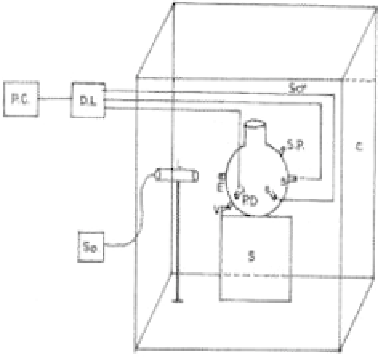Geoscience Reference
In-Depth Information
2. Experiment
The experiment was carried out inside a single-door cold room of dimensions
1.52 m, 1.52 m, and 1.83 m as length, breadth, and height, respectively
(Fig. 1). The body of the room is made of galvanized iron sheet and is insu-
lated by PUF. The temperature of the room can be reduced up to
35
◦
C.
An air-conditioner is operated outside the room so that the temperature
difference between outside and inside the cold room can be reduced. One
thermistor is used to note the temperature inside the cold room and another
is used to note that of the outside. Both temperatures have digital display.
Inside the room, a spherical glass vessel of diameter 35
−
10
−
3
mand
.
6
×
10
−
3
m
3
capacity is placed, and it has several outlets on its body.
A cloud of supercooled droplets was produced by cooling the vessel and
passing steam through a hole near the floor of the vessel. A closed container
with water was used to produce steam and it entered the vessel through
a pipeline. The amount of water vapor inside the vessel was controlled by
adjusting the steam flow. The seeding material was injected inside the vessel
through a port. Two thermistors were used to measure the temperature
inside the vessel. Of the two, one was kept near the floor of the vessel and
the other, kept just above the seeding port. The seeding temperature being
mentioned in the literature was that noted in the second thermistor, as
nucleation mostly occurs in its neighborhood. Two thermistors were used
to find the temperature gradient inside the vessel. All the thermistors were
20
×
Fig. 1.
Schematic arrangement of experimental apparatus inside the cold room.








